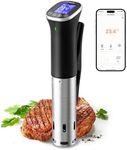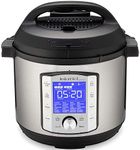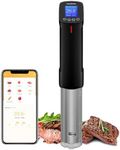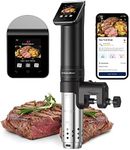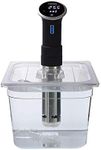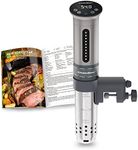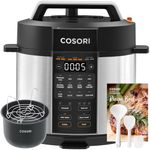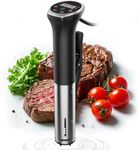Buying Guide for the Best Sous Vide Cookers
Sous-vide cookers are a fantastic tool for achieving precise and consistent cooking results. They work by heating water to a specific temperature and maintaining it, allowing food to cook evenly and retain moisture. When choosing a sous-vide cooker, it's important to consider several key specifications to ensure you get the best fit for your cooking needs. Here are the main specs to look out for and how to navigate them.Temperature RangeThe temperature range of a sous-vide cooker determines the variety of dishes you can prepare. This spec is important because different foods require different cooking temperatures. Most sous-vide cookers offer a range from around 77°F to 210°F (25°C to 99°C). If you plan to cook a wide variety of foods, including delicate items like fish or eggs, look for a cooker with a broad temperature range. For general use, a standard range will suffice.
Temperature AccuracyTemperature accuracy refers to how precisely the sous-vide cooker can maintain the set temperature. This is crucial for achieving consistent results, especially for recipes that require exact temperatures. Accuracy is usually within ±0.1°F to ±1°F. For most home cooks, an accuracy within ±0.5°F is sufficient. If you are a perfectionist or plan to cook very delicate dishes, opt for a model with higher accuracy.
Circulation PumpThe circulation pump ensures that water flows evenly around the food, maintaining a consistent temperature throughout the cooking process. This spec is important for even cooking. Pumps are usually rated by their flow rate, measured in gallons per minute (GPM) or liters per minute (LPM). Higher flow rates (e.g., 2 GPM or more) are better for larger water baths and more even cooking. For smaller batches, a lower flow rate will suffice.
Ease of UseEase of use encompasses the design and user interface of the sous-vide cooker. This includes how easy it is to set the temperature, start the device, and monitor the cooking process. Look for models with intuitive controls, clear displays, and possibly app connectivity for remote monitoring. If you prefer simplicity, choose a model with straightforward, manual controls. For tech-savvy users, app-connected models offer more flexibility and convenience.
Size and PortabilitySize and portability refer to the physical dimensions and weight of the sous-vide cooker. This is important if you have limited kitchen space or plan to store the device when not in use. Smaller, more compact models are easier to store and transport, but may have lower power and fewer features. Larger models might offer more power and features but require more storage space. Choose based on your kitchen space and how often you plan to move the device.
Build Quality and DurabilityBuild quality and durability indicate how well the sous-vide cooker is constructed and how long it will last. This is important for long-term use and reliability. Look for models made with high-quality materials like stainless steel and durable plastics. Reading user reviews can also give insights into the longevity and reliability of the device. If you plan to use the cooker frequently, investing in a well-built model is advisable.
Additional FeaturesAdditional features can enhance the functionality and convenience of the sous-vide cooker. These might include timers, Wi-Fi or Bluetooth connectivity, and pre-set cooking programs. While not essential, these features can make the cooking process more convenient and versatile. Consider what additional features would be useful for your cooking style. If you enjoy experimenting with different recipes, features like pre-set programs and connectivity might be beneficial.
